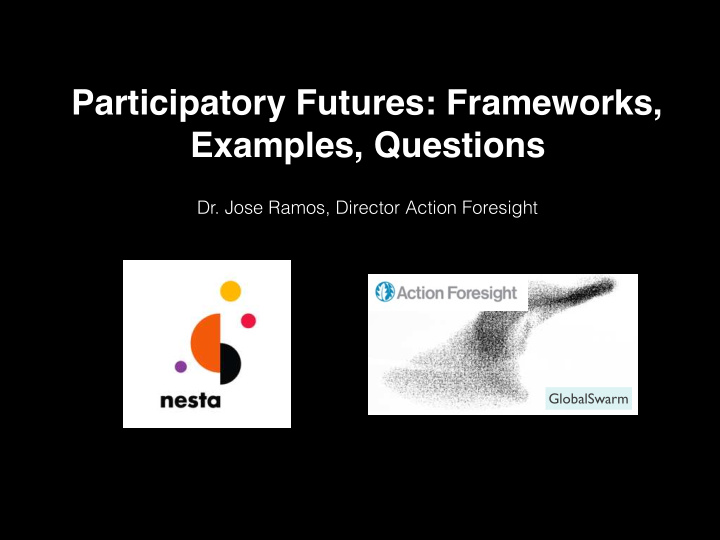



Participatory Futures: Frameworks, Examples, Questions Dr. Jose Ramos, Director Action Foresight GlobalSwarm
2
3
4
5
6
7
“ Participatory Futures refers to a range of approaches for involving citizens in exploring or shaping potential futures. It aims to democratise and encourage long- term thinking, and inform collective actions in the present.” 8
In 2019 we worked with Nesta to document Participatory Futures projects around the world - to find the most interesting, cutting edge and impactful projects. 9
10
We documented 300+ examples from around the world. 11
12
PF Futures Public Studies Engagement 13
Preposterous! “impossible” “won’t ever happen” Possible Future Knowledge “might happen” Plausible Current Knowledge “could happen” The ‘Projected’ Future The ‘default’ extrapolated Now ‘business as usual’ future Probable Current Trends “likely to happen” Time FutureS Based on Joe Voros’ Futures Cone 14
How do we help people to think rigorously and critically about probable, possible, preferred …. futures, and empower informed action? 15
Scale challenge 20 people 2000 people 2,000,000 people Workshop Community Public 16
How do we mobilise far larger numbers of people in thinking about the future – and tap into distributed knowledge and expertise? 17
How does PF fit into organisational decision making? 18
19
Creating Purpose Mapping Horizons Charting Pathways Acting Together Testing Ideas
Creating Purpose 20 Photo by Jamie Street on Unsplash
Mapping Horizons 21 Photo by 360 B on Unsplash
Charting Pathways 22
Acting Together 23
Testing Ideas 24 Source: Stuart Candy
Create Sense Play Immerse Deliberate 25
Play 26
Immerse 27
28
29
Sense 30
31
Create 32
33
Deliberate 34
35
How can we use art, embodied and experiential processes to engage citizens in thinking about the future and acting for the future? What approaches will effectively influence citizens, their sense of meaning, motivation and subsequent actions? 36
Public engagement is often a statutory requirement - a process that “must be done” - an exercise in good governance, due process and legitimation. What if this obligation was transformed into an opportunity, because … 37
• Engaging larger numbers of people in long term thinking strengthens our democracy, • The ability to create coherence / consensus / convergence on decisions that account for the future (generations, species) can help rebuild trust in institutions, • Engaging citizens in new ways of thinking (art, embodied and experiential processes) taps collective intelligence, motivation and generates better assumptions about the futures, • Future informed citizens can drive actions and behaviours in the present to address the challenges that 38 matter most.
Partnership between citizens and government - government can muster resources but cannot achieve outcomes without strong community and sector collaboration and partnership. Where does PF point toward in terms of government - citizen partnership? 39
Collective Intelligence - how do we leverage the embodied knowledges and expertise distributed across society, and the wisdom that can emerge through participation, to address future challenges? 40
Democratising long-term thinking for collective action - how can PF help to build social capacity and responsibility for change? 41
New approaches / mutant futures - how are future challenges asking us to reinvent public engagement? What are the opportunities for leveraging PF to address emerging challenges and issues, especially challenges government is struggling with? 42
Thank You
Recommend
More recommend